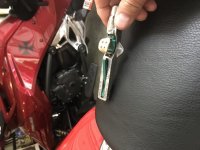stevehendo34
New member
Any way to check without special tool.
What is the Kriket spec for the Spyder??
The "kriket" works great and it cost about $12. You can also do the finger thing. Halfway between the sprockets, twist your belt 180 degrees. The amount of pressure it takes to achieve that twist will give you an idea of the belt's tension. Yep, it takes know-how and experience to achieve that skill. Opinions vary from 160 lbs to 200 lbs.
The old Harley riders trick is if you can turn it more than 90° using your fingers (not grasped in the hand), it's too loose. If you can only turn in less than 90°, it's too tight. After tensioning my belt I've checked it this way and it's pretty close. Closer than an improperly used Krikit IMHO.

Electric don't need no drive shaft. But by great great grandkid time electric will be the past.
You rear want the electric drive motor as part on the unsprung weight on the rear wheel, or are you wanting three really small electric motors?
Motor per wheel. If they keep going the motor may weigh less than the pulley, belt, etc. on there now. Brakes could be smaller cause the motors could share part of that load. Glad I most likely will never see it!
